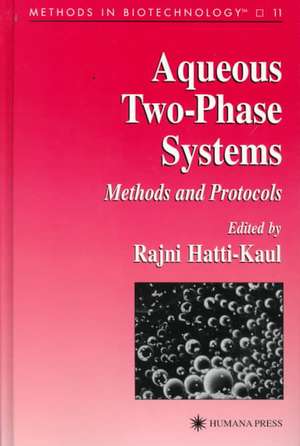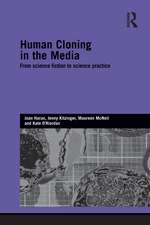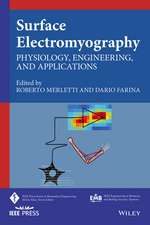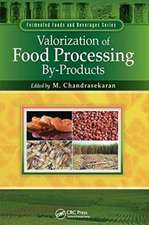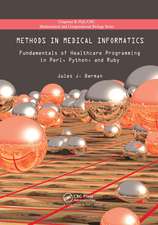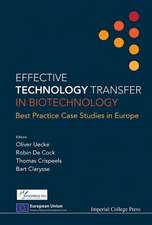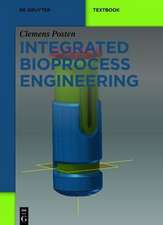Aqueous Two-Phase Systems: Methods and Protocols: Methods in Biotechnology, cartea 11
Editat de Rajni Hatti-Kaulen Limba Engleză Hardback – 21 feb 2000
| Toate formatele și edițiile | Preț | Express |
|---|---|---|
| Paperback (1) | 649.87 lei 6-8 săpt. | |
| Humana Press Inc. – 19 noi 2010 | 649.87 lei 6-8 săpt. | |
| Hardback (1) | 656.43 lei 6-8 săpt. | |
| Humana Press Inc. – 21 feb 2000 | 656.43 lei 6-8 săpt. |
Din seria Methods in Biotechnology
- 15%
 Preț: 648.74 lei
Preț: 648.74 lei - 15%
 Preț: 650.69 lei
Preț: 650.69 lei - 15%
 Preț: 639.90 lei
Preț: 639.90 lei - 18%
 Preț: 953.52 lei
Preț: 953.52 lei - 18%
 Preț: 969.93 lei
Preț: 969.93 lei - 18%
 Preț: 954.14 lei
Preț: 954.14 lei - 18%
 Preț: 952.57 lei
Preț: 952.57 lei - 18%
 Preț: 963.15 lei
Preț: 963.15 lei - 18%
 Preț: 961.23 lei
Preț: 961.23 lei - 15%
 Preț: 652.31 lei
Preț: 652.31 lei - 15%
 Preț: 651.19 lei
Preț: 651.19 lei - 18%
 Preț: 953.52 lei
Preț: 953.52 lei - 18%
 Preț: 962.35 lei
Preț: 962.35 lei - 18%
 Preț: 955.56 lei
Preț: 955.56 lei - 15%
 Preț: 649.87 lei
Preț: 649.87 lei - 18%
 Preț: 964.71 lei
Preț: 964.71 lei - 15%
 Preț: 648.05 lei
Preț: 648.05 lei - 15%
 Preț: 632.66 lei
Preț: 632.66 lei - 15%
 Preț: 643.99 lei
Preț: 643.99 lei
Preț: 656.43 lei
Preț vechi: 772.26 lei
-15% Nou
Puncte Express: 985
Preț estimativ în valută:
125.60€ • 131.50$ • 103.93£
125.60€ • 131.50$ • 103.93£
Carte tipărită la comandă
Livrare economică 07-21 aprilie
Preluare comenzi: 021 569.72.76
Specificații
ISBN-13: 9780896035416
ISBN-10: 0896035417
Pagini: 440
Ilustrații: XIV, 454 p.
Dimensiuni: 152 x 229 x 34 mm
Greutate: 0.86 kg
Ediția:2000
Editura: Humana Press Inc.
Colecția Humana
Seria Methods in Biotechnology
Locul publicării:Totowa, NJ, United States
ISBN-10: 0896035417
Pagini: 440
Ilustrații: XIV, 454 p.
Dimensiuni: 152 x 229 x 34 mm
Greutate: 0.86 kg
Ediția:2000
Editura: Humana Press Inc.
Colecția Humana
Seria Methods in Biotechnology
Locul publicării:Totowa, NJ, United States
Public țintă
ResearchCuprins
Preparation and Characterization of Aqueous Two-Phase Systems.- Aqueous Two-Phase Systems.- The Phase Diagram.- Preparation of Aqueous Two-Phase Systems.- Measurement of Some Physical Properties of Aqueous Two-Phase Systems.- Partitioning Techniques.- Single-Step Partitioning in Aqueous Two-Phase Systems.- Partition by Countercurrent Distribution (CCD).- Liquid-Liquid Partition Chromatography (LLPC).- Partitioning of Soluble Molecules and Particulates.- Metal Ion Separations in Aqueous Biphasic Systems and with ABEC™ Resins.- Partition of Amino Acids and Peptides in Aqueous Two-Phase Systems.- Predicting Partition Coefficients of Small Solutes Based on Hydrophobicity.- Eukaryotic Cell Partition.- Concentration and Purification of Viruses.- Isolation of Plant Plasma Membranes and Production of Inside-Out Vesicles.- Isolation of Inside-Out Thylakoid Vesicles.- Two-Phase Partitioning as a Method for Isolation of Tight Plasma Membrane Vesicles from Saccharomyces cerevisiae and from Chlamydomonas reinhardtii.- Purification of Cyanobacterial Thylakoid, Plasma, and Outer Membranes by Two-Phase Partitioning.- Purification of Plasma Membranes by Affinity Partitioning.- Studying the Influence of Salts on Partitioning of Proteins.- Partitioning of Chemically Modified Proteins.- Detection and Analysis of Interactions by Two-Phase Partition.- Cryopartitioning in Two-Phase Systems Containing Organic Solvents.- Isolation and Purification of Proteins by Two-Phase Extraction.- Optimization of Extractions in Aqueous Two-Phase Systems.- Two-Phase Extraction of Proteins from Cell Debris.- Aqueous Two-Phase Extraction of Proteins from Animal Tissue.- Chaotropic Aqueous Two-Phase Systems.- Temperature-Induced Phase Partitioning for Protein Purification.- Extraction of Amphiphilic ProteinsUsing Detergent-Based Aqueous Two-Phase Systems.- Use of Charged PEG and Dextran Derivatives for Biomolecule Partitioning.- Affinity Partitioning Using Poly(ethylene glycol) with Covalently Coupled Hydrophobic Groups.- Dye-Ligand Affinity Partitioning of Proteins.- Metal Affinity Protein Partitioning.- Recovery of Proteins and Phase Components.- Combination of Extraction with Adsorption for Protein Purification.- Integration of Extraction with Affinity Precipitation.- Affinity Partitioning Using Magnetic Two-Phase Systems.- 36 Large-Scale Extraction of Proteins.- Bioconversions in Two-Phase Systems.- Extractive Bioconversion in Aqueous Two-Phase Systems.- Enzyme Reaction in Polymer-Polymer Organic Solvent Two-Phase Systems.
Textul de pe ultima copertă
In Aqueous Two-Phase Systems: Methods and Protocols, Rajni Hatti-Kaul and her expert coauthors combine theory, methodology, and applications in a practical collection of easily reproducible protocols for bioseparations in aqueous two-phase systems (ATPS). The protocols range from established methods to cutting-edge techniques with potential biotechnological applications, all presented in set-by-step detail to ensure easy reproducibility and robust results. Among the methods detailed are those for ATPS preparation and characterization, for partitioning applied to soluble molecules and particulates (including whole cells, membranes, and organelles), and for the isolation and purification of proteins-including a glimpse of large-scale handling of two-phase separations. Techniques for in situ product recovery during biocatalytic processes and for polymer-polymer systems in organic solvents are also presented.
Practical and informative, with its detailed guidelines allowing researchers to adapt specific systems to their own separation needs, Aqueous Two-Phase Systems: Methods and Protocols demonstrates the scope and utility of two-phase aqueous systems in both basic and applied research.
Practical and informative, with its detailed guidelines allowing researchers to adapt specific systems to their own separation needs, Aqueous Two-Phase Systems: Methods and Protocols demonstrates the scope and utility of two-phase aqueous systems in both basic and applied research.
Caracteristici
Includes supplementary material: sn.pub/extras
